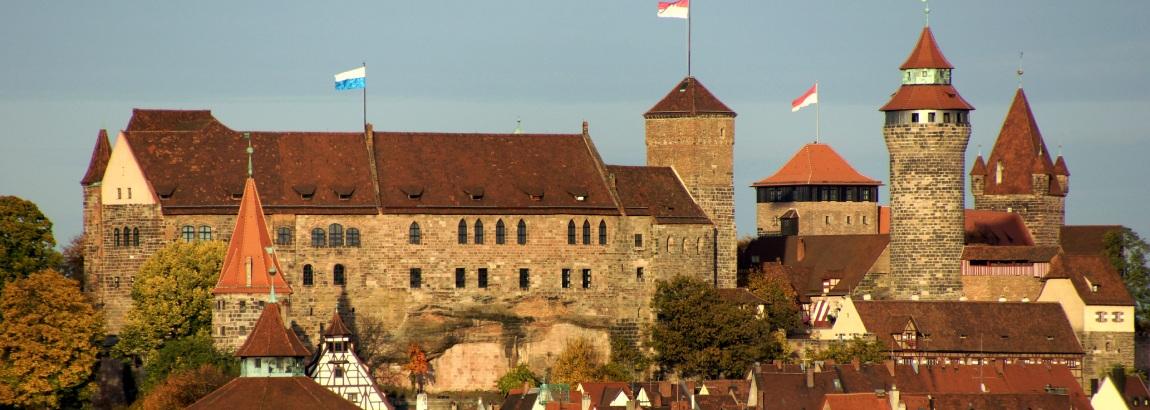
Informal titles and nicknames of Nuremberg are “Treasury of the German Empire”, “Dürerstadt”, “Meistersingerstadt”, “City of Christkindlsmarkt”, the city of toys, Lebkuchen gingerbread and Bratwurst sausages.
one of the most significant cultural and historical monuments of the city of Nuremberg. It consists of the Imperial Fortress in the western part and the Burggrave Fortress in the eastern part. The fortress is located north of the river Pegnitz on top of a cliff overlooking the Seebald Old Town. From the fortress observation deck, facing south, a magnificent view of the Craftsmen's Quarter and the Old Town lies below it.
located in the old part of Nuremberg, built around 1420, the place where the artist lived and worked from 1509 until his death in 1528. Durer lived in a house with his wife, mother and his students and apprentices. Today the house is a museum and belongs, together with the Nuremberg Graphic Collection, to the union of the city's museums.
the largest art and history museum in German-speaking Europe. The museum's collection includes about 1.3 million exhibits. Founded by Hans Philipp von Aufses in 1852 as the German Museum. The modern museum complex includes the buildings of the large Nuremberg Carthusian monastery.
is a municipal museum that was founded in 1971. It is considered one of the most famous toy museums in the world, presenting the history of toy culture from antiquity to the present day. The core of the museum's collection is about 12,000 toys collected over decades by Lydia (1897–1961) and Paul Bayer (1896–1982).
the oldest of Nuremberg's large city churches and the city's oldest Lutheran parish church. Construction of the building began in the 1230s. The church attained the status of a parish church in 1255 and was completed 1273–75. In the middle of the galleries of the 17th century, the building and its interior were reconstructed in the Baroque style. The church was almost destroyed by Allied bombing during World War II, but was subsequently rebuilt. A part of the interior has survived, including the shrine of St. Sebald, the work of Veit Stoss and the stained glass windows.
museum in Nuremberg, founded at the end of the 19th century. It consists of the Museum of the German Railways and the Museum of Communications. The Nuremberg Transport Museum is one of the oldest technical history museums in Europe. Nuremberg was the first German city to have a railway in 1835. In February 2007, the name "Deutsche Bahn Museum" became the official name of the Deutsche Bahn Museum.
it is one of the most important medieval churches in the former free imperial city of Nuremberg and one of the first churches in Germany to become Lutheran. The first references to the Laurentius Chapel in Nuremberg date back to 1235 and 1258; the plan of this chapel was partially established during excavations in 1929. The church acquired its present form in the 15th century. The church, badly damaged by air raids during World War II, was rebuilt in 1949. The church organ is the second largest in Germany and the largest among the organs in the Evangelical Church in Germany.
German multi-theater complex in Nuremberg. The fourth state theater in Bavaria. Officially, the City Theater of Nuremberg was opened on October 1, 1945. In terms of the content of productions, the focus in the 1950s and 1960s was on operetta and contemporary works. In 1955, the 50th anniversary of the theater was celebrated. A significant work in the history of Nuremberg opera was the work "Seelewig", composed by the city organist and composer Sigmund Staden. This play is the first surviving German opera, its text was written by Georg Harsdörffer, co-founder of the literary association Pegnitz Flower Order.
This 14th-century fountain is located in Nuremberg's main market next to the town hall and is considered one of the main attractions of the city's Historic Mile. The fountain is about 19 meters high and has the shape of a Gothic spire.
The easiest way to purchase air tickets to Nuremberg and back is to use the online booking service of the AVIA.MD. Payment is also carried out remotely, without the need to visit the office. Find out with what bank cards you can pay for air tickets. The purchase and sale agreement for air tickets can be easily read online. If you need access to the Terms of Service, you can read online at AVIA.MD.
Also, in order to get the most out of your travel, while buying an air ticket, the AVIA.MD website provides online booking of a room in one of the many hotels in Nuremberg.
To make your trip as comfortable and enjoyable as possible, avia.md offers an easy-to-use platform for booking flight tickets. Follow these simple steps to book your tickets:
With avia.md, booking flights is easy and fast, so you can focus on planning your stay in Germany.